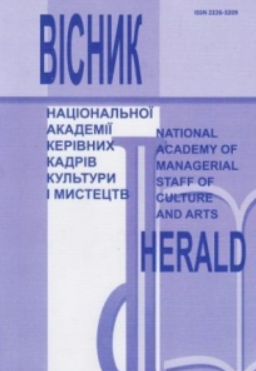ПРОДЮСЕР ЯК КЛЮЧОВА ПОСТАТЬ АРТ-РИНКУ ПОСТМОДЕРНОЇ КУЛЬТУРИ ХХІ СТОЛІТТЯ
PRODUCER AS A KEY FIGURE IN THE ART MARKET OF POSTMODERN CULTURE
Author(s): Igor Leonidovich LikhutaSubject(s): Business Economy / Management, Sociology of Culture, Sociology of Art
Published by: Національна академія керівних кадрів культури і мистецтв
Keywords: producer; art market; art product; postmodern culture; altermodern; creative economy;
Summary/Abstract: The purpose of the article is to analyze the activities of the producer and cultural and anthropological understanding of the producer as a key figure in the art market of the postmodern culture of the XXI century. Methodology. The conceptual methodological core of the study is a comparative analysis of production as a phenomenon of modern culture and, in particular, culturological analysis of the figure of the producer as a symbolic subject in the light of the progressive development of the third wave society. Using the method of hermeneutic interpretation, the peculiarities of the producer's activity as a key figure in the art market of postmodern culture are revealed. The scientific novelty lies in the conceptualization of the figure of the producer as a phenomenon of humanitarian knowledge of the postmodern culture. It is hypothesized that the worldview of the new synthetic worldview of the producer may be a new paradigm that replaces the third wave: altermodern. Its characteristic features are glocalization, cluster practice, transculture, etc. Conclusions. Understanding of production as a phenomenon of the art market and the figure of the producer (entrepreneur, manager) as a key figure in the creative economy showed that this model of economic relations belongs to the third wave and is a typical manifestation of symbolic exchange. The specificity of the economy of experiences is the escalation of the free market, which through universal enthusiasm tries to appropriate the sphere of artistic culture and turn art products into brands and goods. The metalanguage of the art market, built on the principles of information aesthetics, provides for diffuse mechanisms of assimilation of the world, with many hybrid forms and gradual displacement by art sponsorship, which becomes a commercial concept. This applies to both individual and national acts of creativity, which is reflected in the practices of multiculturalism. The development of symbolic exchange in the creative economy has led to the institutionalization of the institution of production as a mechanism of mediation between the artist and the public, which needs an accessible art product that can differently affect the ontological adequacy of the work.
Journal: Вісник Національної академії керівних кадрів культури і мистецтв
- Issue Year: 2021
- Issue No: 1
- Page Range: 186-191
- Page Count: 6
- Language: Ukrainian

